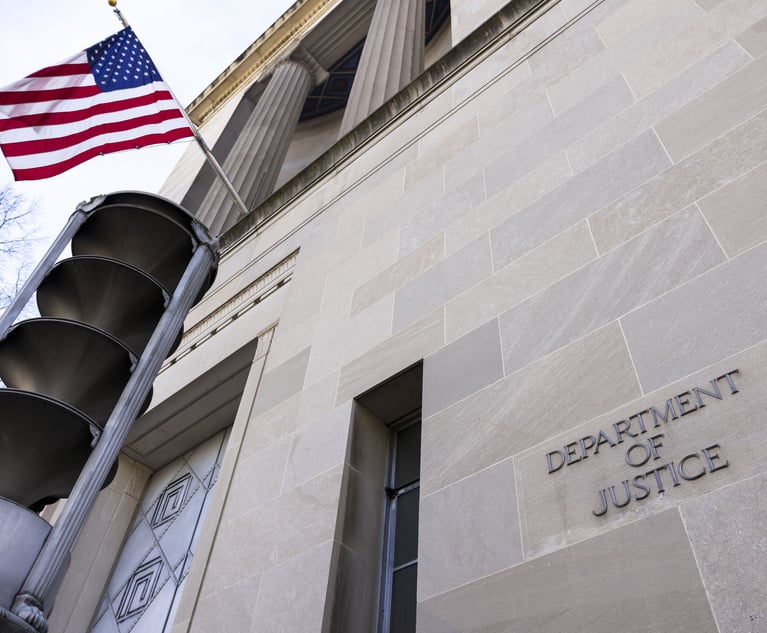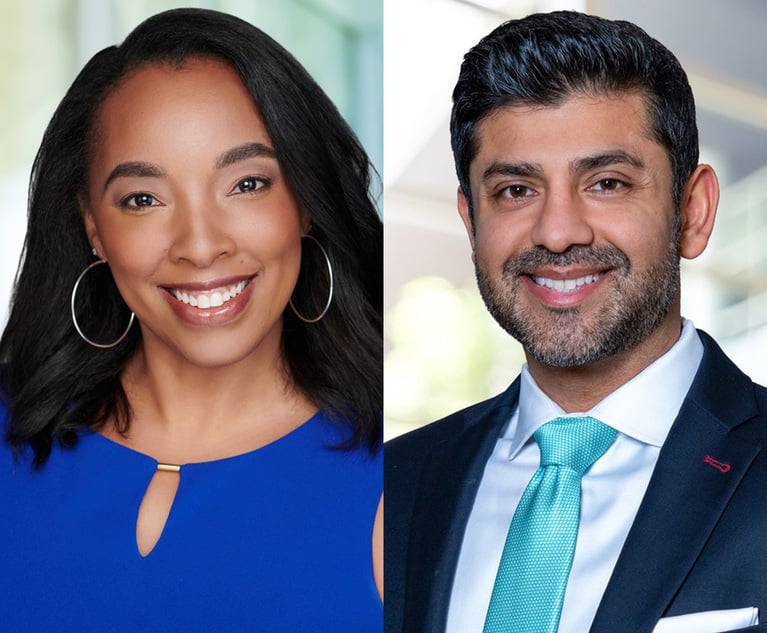Partners at These Am Law 200 Firms Make Less Than Cravath Associates
The latest round of bonuses means senior associates at top-paying firms can now expect to make $465,000 or more—higher than the average profits per equity partner at plenty of Big Law firms.
November 21, 2018 at 10:20 AM
3 minute read
 (Photo: Andrey_Popov/Shutterstock.com)
(Photo: Andrey_Popov/Shutterstock.com)
Cravath, Swaine & Moore kicked off the Big Law year-end bonus pageant on Monday, telling first-year associates they're set to receive $15,000 and granting senior associates up to $100,000.
As in past years, other Am Law firms were quick to match Cravath's bonus scale, including Fried, Frank, Harris, Shriver & Jacobson; Milbank, Tweed, Hadley & McCloy; Paul, Weiss, Rifkind, Wharton & Garrison; and Skadden, Arps, Slate, Meagher & Flom—while some boutiques are forking over even more.
The payouts come on the heels of significant associate salary increases and midyear bonuses announced this summer, first by Milbank and later surpassed by Cravath. Coupled with the new year-end bonuses, the most senior associates at Cravath and other top-tier firms now stand to take home $465,000.
Nearly $500,000 is a lot of money by any measure. It's also more than the average partner makes at a dozen Am Law 200 firms, according to ALM data.
Average profits per equity partner were below $465,000 last year at Bond, Schoeneck & King; Dinsmore & Shohl; Eckert Seamans Cherin & Mellott; GrayRobinson; Holland & Hart; Kutak Rock; Lane Powell; LeClairRyan; Littler Mendelson; Marshall Dennehey Warner, Coleman & Goggin; Shumaker, Loop & Kendrick; and Wilson Elser Moskowitz Edelman & Dicker. In contrast, Cravath had the fifth-highest reported PPP last year, at just over $4 million. Wachtell led the pack with PPP of $5.7 million.
The fact that senior associates at some firms can outearn partners at others—even within the Am Law 200—is just more evidence of industry stratification, said Kent Zimmermann, a law firm management consultant at the Zeughauser Group.
The top-tier firms are benefiting from compounding year-over-year and paying higher average compensation, which gives them a recruiting advantage, he said.
“Many firms are updating their strategy to account for increasing competition for sought-after lawyers,” Zimmermann said, citing increased merger activity as a sign of the pressures firms are facing.
Brad Hildebrandt, CEO of Hildebrandt Consulting, pointed out that law school enrollments have been down in recent years and, while they've stabilized a bit over time, that has still had an effect on the talent pool. “It's a recruiting and retention issue,” he said.
“For the top firms, they are all trying to recruit the same group of people,” Hildebrandt said, noting that 2018 is turning out to be a very good year for law firms in terms of revenue. But attrition rates are also high, with millennial lawyers tending to leave after three to four years in Big Law, he said.
“Many firms have a shortage of associates in the five- to eight-year range,” Hildebrandt said. “You add all of that together, it always translates into higher salaries, and now it's translating into a bonus.”
Beyond bonuses, Big Law has spent the last year wooing associates with new programs and policies. Among other initiatives, several firms implemented expanded parental leave policies, as well as various flexible remote working programs.
Others have revamped their annual review processes in favor of more informal evaluations. Weil, Gotshal & Manges also shortened its path to partnership by two years in an attempt to hang onto associates who might otherwise leave in their fourth or fifth years.
READ MORE:
A Week Early, Cravath Kicks Off Associate Bonus Season
NY Boutique Holwell Shuster Quick To Follow Cravath Bonus Scale
This content has been archived. It is available through our partners, LexisNexis® and Bloomberg Law.
To view this content, please continue to their sites.
Not a Lexis Subscriber?
Subscribe Now
Not a Bloomberg Law Subscriber?
Subscribe Now
NOT FOR REPRINT
© 2025 ALM Global, LLC, All Rights Reserved. Request academic re-use from www.copyright.com. All other uses, submit a request to [email protected]. For more information visit Asset & Logo Licensing.
You Might Like
View All
Government Attorneys Face Reassignment, Rescinded Job Offers in First Days of Trump Administration
4 minute read


Energy Lawyers Field Client Questions as Trump Issues Executive Orders on Industry Funding, Oversight
6 minute readTrending Stories
- 1New York-Based Skadden Team Joins White & Case Group in Mexico City for Citigroup Demerger
- 2No Two Wildfires Alike: Lawyers Take Different Legal Strategies in California
- 3Poop-Themed Dog Toy OK as Parody, but Still Tarnished Jack Daniel’s Brand, Court Says
- 4Meet the New President of NY's Association of Trial Court Jurists
- 5Lawyers' Phones Are Ringing: What Should Employers Do If ICE Raids Their Business?
Who Got The Work
J. Brugh Lower of Gibbons has entered an appearance for industrial equipment supplier Devco Corporation in a pending trademark infringement lawsuit. The suit, accusing the defendant of selling knock-off Graco products, was filed Dec. 18 in New Jersey District Court by Rivkin Radler on behalf of Graco Inc. and Graco Minnesota. The case, assigned to U.S. District Judge Zahid N. Quraishi, is 3:24-cv-11294, Graco Inc. et al v. Devco Corporation.
Who Got The Work
Rebecca Maller-Stein and Kent A. Yalowitz of Arnold & Porter Kaye Scholer have entered their appearances for Hanaco Venture Capital and its executives, Lior Prosor and David Frankel, in a pending securities lawsuit. The action, filed on Dec. 24 in New York Southern District Court by Zell, Aron & Co. on behalf of Goldeneye Advisors, accuses the defendants of negligently and fraudulently managing the plaintiff's $1 million investment. The case, assigned to U.S. District Judge Vernon S. Broderick, is 1:24-cv-09918, Goldeneye Advisors, LLC v. Hanaco Venture Capital, Ltd. et al.
Who Got The Work
Attorneys from A&O Shearman has stepped in as defense counsel for Toronto-Dominion Bank and other defendants in a pending securities class action. The suit, filed Dec. 11 in New York Southern District Court by Bleichmar Fonti & Auld, accuses the defendants of concealing the bank's 'pervasive' deficiencies in regards to its compliance with the Bank Secrecy Act and the quality of its anti-money laundering controls. The case, assigned to U.S. District Judge Arun Subramanian, is 1:24-cv-09445, Gonzalez v. The Toronto-Dominion Bank et al.
Who Got The Work
Crown Castle International, a Pennsylvania company providing shared communications infrastructure, has turned to Luke D. Wolf of Gordon Rees Scully Mansukhani to fend off a pending breach-of-contract lawsuit. The court action, filed Nov. 25 in Michigan Eastern District Court by Hooper Hathaway PC on behalf of The Town Residences LLC, accuses Crown Castle of failing to transfer approximately $30,000 in utility payments from T-Mobile in breach of a roof-top lease and assignment agreement. The case, assigned to U.S. District Judge Susan K. Declercq, is 2:24-cv-13131, The Town Residences LLC v. T-Mobile US, Inc. et al.
Who Got The Work
Wilfred P. Coronato and Daniel M. Schwartz of McCarter & English have stepped in as defense counsel to Electrolux Home Products Inc. in a pending product liability lawsuit. The court action, filed Nov. 26 in New York Eastern District Court by Poulos Lopiccolo PC and Nagel Rice LLP on behalf of David Stern, alleges that the defendant's refrigerators’ drawers and shelving repeatedly break and fall apart within months after purchase. The case, assigned to U.S. District Judge Joan M. Azrack, is 2:24-cv-08204, Stern v. Electrolux Home Products, Inc.
Featured Firms
Law Offices of Gary Martin Hays & Associates, P.C.
(470) 294-1674
Law Offices of Mark E. Salomone
(857) 444-6468
Smith & Hassler
(713) 739-1250










